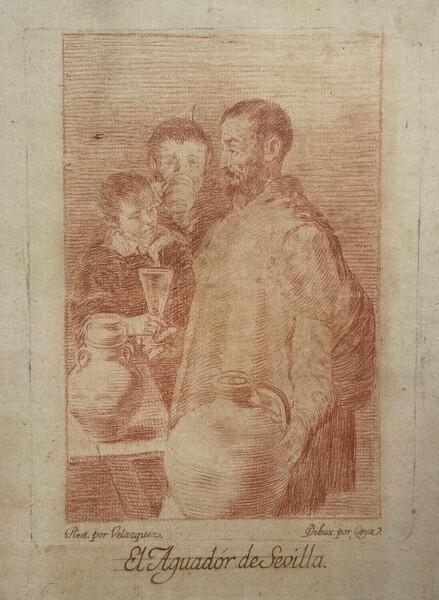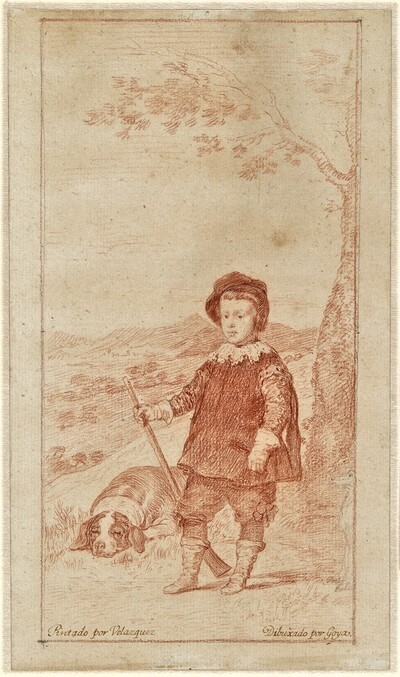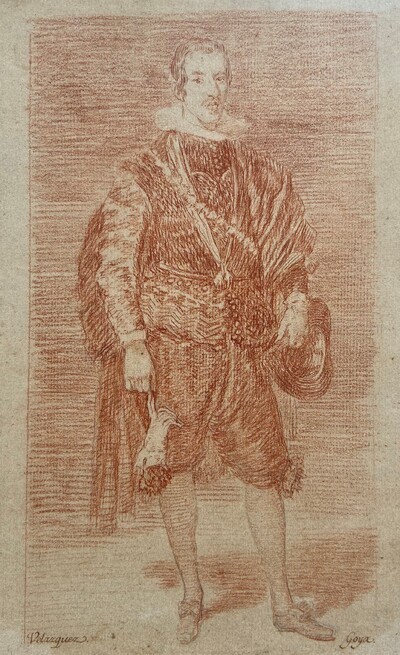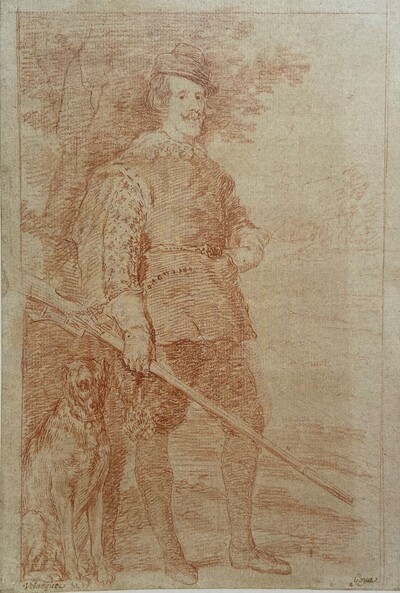- Cronología
- Ca. 1778 - 1779
- Ubicación
- Hamburger Kunsthalle, Hamburg, Germany
- Dimensiones
- 252 x 186 mm
- Técnica y soporte
- Reconocimiento de la autoría de Goya
- Documented work
- Titular
- Hamburger Kunsthalle
- Ficha: realización/revisión
- 07 Jul 2021 / 26 Apr 2023
- Inventario
- Inv. 38537
Pint. by Velazquez [in pen, lower left].
Dibux. by Goya [in pen, lower right].
The Water Carrier of Seville [in pen, lower centre] Dibux. by Goya [in pen, lower centre
See Philip III.
In 1775 Goya was working, under the supervision of his brother-in-law Francisco Bayeu and the first chamber painter Anton Raphael Mengs, on tapestry cartoons to decorate the rooms of the Royal Palace in Madrid, where he discovered and admired the works of the great Diego Velazquez. In a letter that Mengs addressed in 1776 to his friend Antonio Ponz, secretary of the San Fernando Royal Academy of Fine Arts, he recommended that young people should imitate the works of the celebrated Sevillian painter in order to understand his method and learn how to capture the effects of light, shadow and aerial perspective, advice that the Aragonese painter certainly followed in the preparation of drawings that imitated works by the Sevillian artist, most of which were later engraved. According to Jesusa Vega, engraving Velázquez's paintings was an opportunity to study the master's work and become more familiar with the technique of painting and engraving, as well as to make himself known at Court and among the professors of fine art, to whom Goya presented the prints for their approval before putting them on sale in the summer of 1778.
Today, the engraving drawings imitating works by Velázquez are scattered in various museums around the world: the Hamburger Kunsthalle, the Victoria and Albert Museum in London, the Prado Museum and the Lazaro Galdiano Museum in Madrid.
The Water Carrier of Seville (ca. 1618-1622) is one of Diego Velazquez's most renowned youthful oil paintings, now in the Wellington Museum, London, after being part of the spoils of war intended to be taken from Spain by Joseph Bonaparte in 1813 and eventually recovered. The work was later given by Ferdinand VII to the Duke of Wellington as a gift of thanks.
Goya's drawing copying this well-known work by Velázquez is executed in sanguine with a fine pen, based on lines and framed by a fine line. According to Jesusa Vega in Velazquez in Black and White, it is possible that in this and other drawings he first drew the main lines with graphite pencil and then used red pencil. The mark of the plate is clearly visible, which means that the drawing was reported on the copper and passed through the press used for printing engravings. However, there is currently no known proof of condition.
Goya's mastery in the execution of this drawing is undeniable, as he remained faithful to the original oil painting. Technically, he drew more lines in the parts that are darker in the oil painting, such as the children's clothes, the hair of the three characters and the protagonist's beard.
This drawing is one of what Gassier-Wilson called additional drawings: five drawings copied from works by Velázquez to be engraved but for which no proof of condition is known. All of them are in the Hamburger Kunsthalle, along with others from the series that were engraved. Apart from the present one, these drawings are: Philip IV, hunter; Prince Balthasar Charles, hunter; The Boy of Vallecas; and The Infant Charles of Austria.
-
Hamburg1966111
-
Goya. Das Zeitalter der Revolucionen. Kunst um 1800 (1980 – 1981)Hamburger KunsthalleHamburg1980208
-
Ydioma universal: Goya en la Biblioteca NacionalBiblioteca NacionalMadrid1996from September 19th to December 15th 1996
-
Dallas2014
-
Madrid2015
-
Vie et ouvre de Francisco de GoyaParísOffice du livre1970pp. 48, 49, 50 y 88, cat. 114.
-
Dibujos de Goya, 2 volsBarcelonaNoguer1975p. 67 (il.), cat. 33.
-
Velázquez en blanco y negroMadridMuseo Nacional del Prado2000p. 227.
-
MadridMuseo Nacional del Prado2000pp. 25-74, espec. pp. 43, 57 y 58.
-
SantanderFundación Botín y Museo Nacional del Prado2018pp. 430-433.




